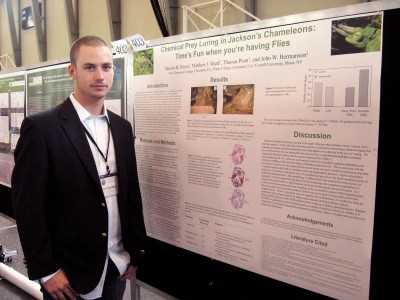 Pitzer College Interim President and Professor of Chemistry Thomas Poon
Pitzer College Interim President and Professor of Chemistry Thomas Poon
Claremont, Calif. (March 30, 2016)—A team of professors and a Pitzer College alumnus have conducted groundbreaking research that shows reptiles are not just hunting prey, but luring them by actively using chemical compounds.
This interdisciplinary research team—consisting of Pitzer College Interim President and Professor of Chemistry Thomas Poon, Pitzer alumnus Matthew Ward ’11, Interim Dean of W.M. Keck Science Department and Professor of Biology Marion Preest and Professor of Biomedical Sciences John Hermanson at Cornell University—released their research “Chemical Prey Luring in Jackson’s Chameleons” in February 2016.
The researchers expanded on an observation of chameleon behavior made in 1966 that showed lizards in the family Chamaeleonidae wiping a foul-smelling, viscous substance from a pouch in their jaws onto branches. The substance appears to lure insects that the lizards can then feed on. Histological testing suggests that the material is not a glandular secretion; rather it is made up of decomposed food and sloughed off skin that has been trapped in the pouch. Using a technique known as gas chromatography-mass spectrometry, the study indicated the presence of compounds that are volatile, odiferous and, in some cases, identical to those used by insects to communicate with each other. Using a specifically designed test, the researchers showed that the materials in the pouch attract houseflies. Some researchers have speculated that the pouch material serves a function in territory marking and predator deterrence. While it may play these roles, the results of Poon, Ward, Preest and Hermanson’s research suggest that it also serves a role in chemically luring prey.
 Matthew Ward ’11
Matthew Ward ’11
This research spanned three years from 2010 to 2013. Ward, who graduated from Pitzer with a degree in biology and minor in art, worked on this project for his senior thesis and research continued after he graduated. The results of this research were recently published in the journal Physiological and Biochemical Zoology and reported by Inside Science.
The W.M. Keck Science Department is a joint program of Pitzer, Claremont McKenna and Scripps colleges.